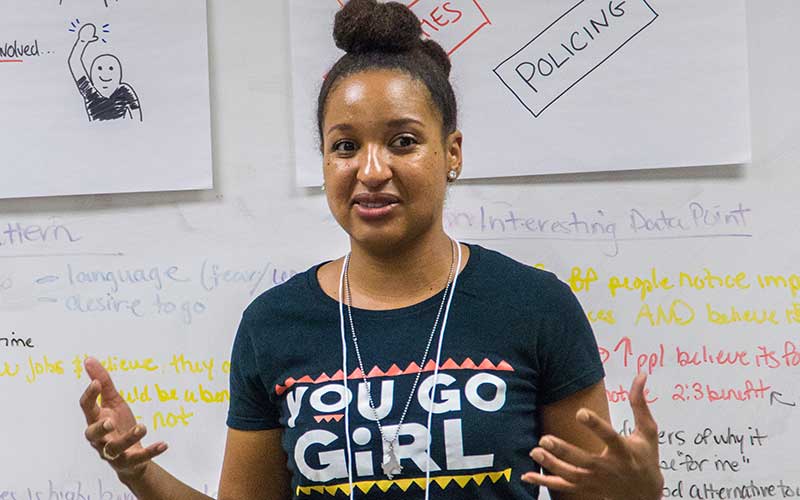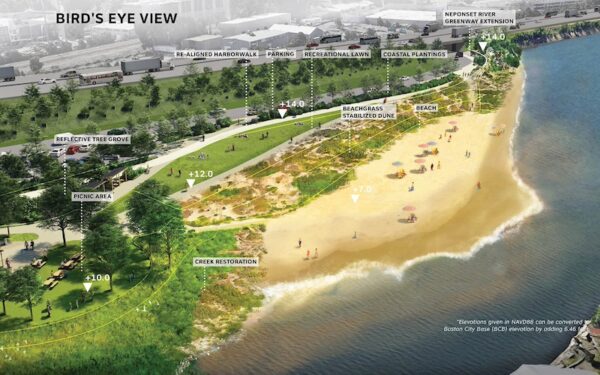
Director of Research and Partnerships Vedette Gavin is using her expertise in public health and applied research to work hand in hand with partners and residents across Massachusetts to use research to build healthier communities.
We are where we live.
Every day our environments shape our lives and our health. We are all connected by the air we breathe, the water we drink, the food we eat, the roads and sidewalks we use, the pipes in our walls, the sewer systems under our feet, the parks where we play, and the schools where our children learn.
In fact, our environments are so important to our health that people living in communities where these conditions are poor in Massachusetts live 15 to 25 years less on average than those living in healthy places. That is environmental injustice, and CLF is using a unique research study to help change it.
Neighborhood Development Can Both Help and Harm Resident Health
Towns and neighborhoods across the Boston-metro area are rapidly changing as more transit, housing, and infrastructure are built to support the area’s growing population. This new wave of development is drastically changing neighborhoods in ways that can help and harm health. New apartments can transform a vacant and polluted lot into clean, safe, and healthy housing and green space. But like a coin with two sides, they can also drive up rents, price people out, and prevent them from enjoying the benefits they spent years fighting for.
To understand the impact of new development on the health and well-being of communities, CLF launched the Healthy Neighborhoods Study in partnership with longtime residents and advocacy organizations in rapidly gentrifying Greater Boston neighborhoods. Together, we are using what we learn to do development differently. The results so far have been powerful.
Innovative Study Puts Local Perspectives First in Solving Community Challenges
We believe, unequivocally, that the people most impacted by environmental injustices are best equipped to solve, design, and advocate for solutions. That’s why the Healthy Neighborhoods Study departs from traditional top-down practices in conducting public health research. It takes an innovative approach that combines people power and big data to understand how neighborhoods are changing. The Study results can then be used to build effective solutions to local health challenges – solutions that come from residents themselves.
The Study launched in 2016 when CLF convened a consortium of community, data, and policy partners. These included local residents, grassroots advocacy organizations, MIT Department of Urban Studies and Planning, the Massachusetts Department of Public Health, and the Metropolitan Area Planning Council to guide the research. To carry out the Study, CLF contracted with nine community-based organizations who employed 45 local “resident researchers” who gather data from nearly 1,000 members of their own communities each year to determine what matters most when it comes to building healthy neighborhoods.
These resident researchers have repeated their data collecting each year since and will continue to do so through 2020. Now in the fifth year of the study, we’re turning the information residents share about their experiences as their communities change into big data that CLF, residents, community partners, and policymakers alike can use to improve the way we build neighborhoods.
Understanding Current Health Factors Can Drive Better Solutions
The consortium is discovering new information about the critical links between the way we build neighborhoods and people’s health. Data from the Study’s first two years show that a myriad of social factors all have a direct impact on community health, including security of income, housing, and food; family and community support; experiences with racism and discrimination; hard tradeoffs due to financial pressures; and loss of connection to family friends, culture, and social services.
The anxiety of worrying about being displaced by rising rents, the stress of local businesses closing, and even the sense of influence people have over the changes happening in their communities can also seriously affect residents’ physical, mental, and emotional health.
Putting Community Members First
Community development and health go hand-in-hand. Understanding this relationship can help improve health and well-being for all. From a community perspective, we use the knowledge we are gathering as a powerful tool to support local advocacy and ensure that development supports and benefits the residents. As one resident researcher stated, “Experience is expertise when analyzing one’s own space, home, or community. Nothing about us should happen without us.”
Community-led research is yet another powerful tool that CLF uses to ensure a healthy, thriving New England for all. As advocates for environmental justice, CLF’s membership is also well positioned to support this far-reaching, collaborative, and community-led effort. At a local, state, and national level, our members can add their voices to efforts to advocate for equitable development policies.
The Study has also informed approaches to social impact investing through efforts such as the Healthy Neighborhoods Equity Fund. This $23 million private equity fund supports healthy neighborhood development by investing in mixed-income, mixed-use, transit-oriented real estate development projects in urban areas across Massachusetts that exhibit poor health outcomes and demonstrate a need for economic growth. Together, the Healthy Neighborhoods Study and Healthy Neighborhoods Equity Fund are helping to improve public health by improving the built environment.
CLF is grateful to receive support for the Healthy Neighborhoods Study and Healthy Neighborhoods Equity Fund from the Robert Wood Johnson Foundation.



